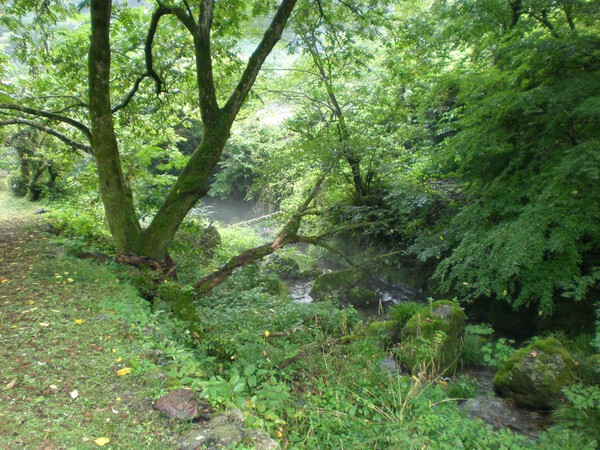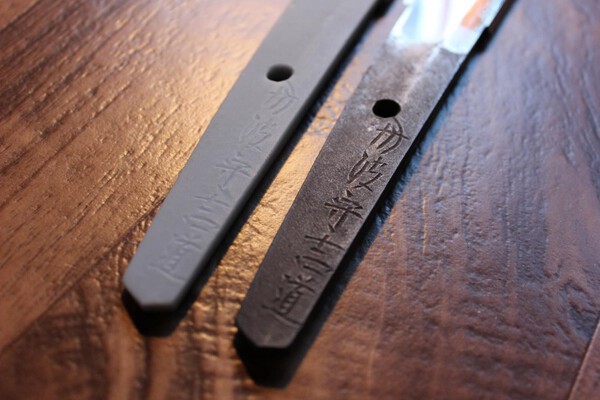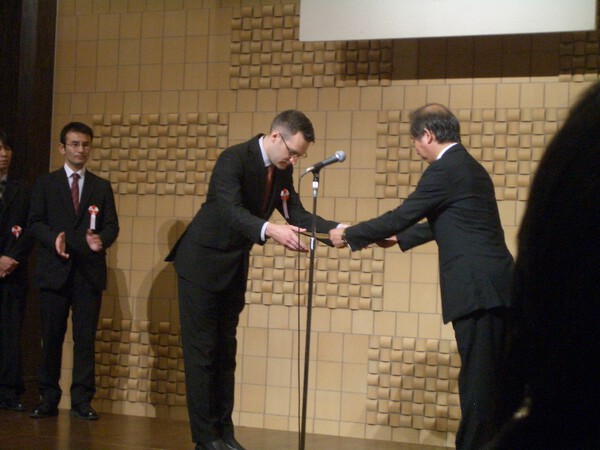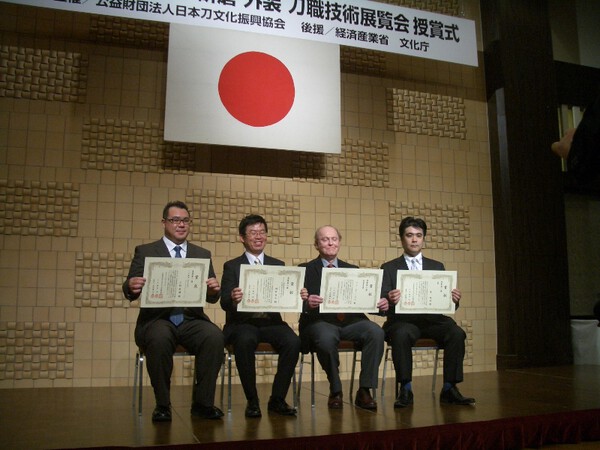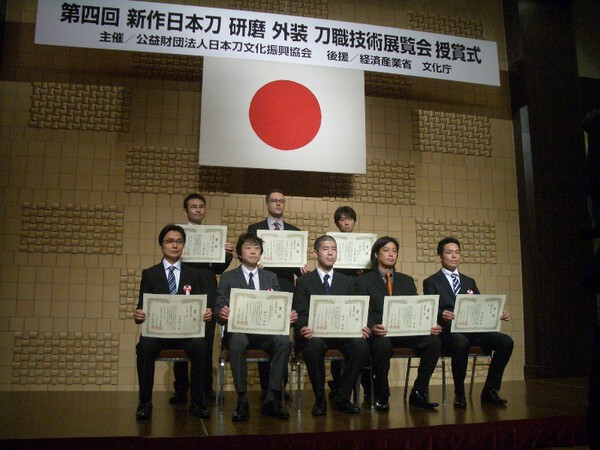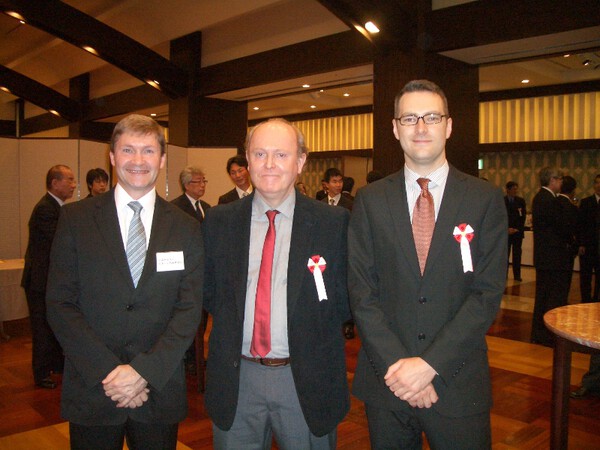-
Posts
53 -
Joined
-
Days Won
6
Content Type
Profiles
Forums
Events
Store
Downloads
Gallery
Everything posted by Andrew Ickeringill
-

Shinto Suriage Tbh?
Andrew Ickeringill replied to TheGermanBastard's topic in Auctions and Online Sales or Sellers
In the world of Nihonto, there are always surprises and exceptions to the "rules"... http://www.nipponto.co.jp/swords3/KT324507.htm -

Best Post Ww2 Smith?
Andrew Ickeringill replied to barnejp's topic in General Nihonto Related Discussion
Hi Joe, that's a good group of names on your list for sure. Yes you're correct Ozawa Masatoshi didn't make Mukansa, that was an error in my original post, also I forgot that Kubo Yoshihiro actually did make Mukansa just last year, I've edited my original post to reflect this. For those interested, here's a handy link listing every Mukansa, Ningen Kokuho and Masamune-sho winners - http://www.tsuruginoya.com/mn1_6/mn6_5_17.html I included Ozawa sensei on my list mainly because of 2 particular swords, a Go utsushi which was possibly the best modern Soshu-den work I've seen, and the other a kogarasu-maru utsushi which was possibly the best modern work I've seen, period. Ozawa sensei passed away before my time, but I know his son Toshihisa who's also an accomplished tosho. We were once invited for a bbq at their family home and forge, maybe the most serene location I've ever been, middle of the mountains, right next to a river, the sake flowed much faster than the river though, was a great day! (I've attached a couple pics from the day) By the way Joe, Takehana san was one of the tosho that would send his competition entries to my sensei, so I got to work on some of his best. They were very much like the following examples with rather elaborate ryu horimono that he'd carved himself - http://katana.art.coocan.jp/Riyu/Riyu.html#2012ryu-daisyou and from memory he won some top prizes in those days, but I haven't seen or heard anything from him in a while. -

Best Post Ww2 Smith?
Andrew Ickeringill replied to barnejp's topic in General Nihonto Related Discussion
Cheers Brian, yes it was unbelievable being able to work on swords by master tosho from all periods during my training, but when working on shinsakuto there was an added connection, the fact that I could talk to that tosho! I was getting info on forging techniques, hearing great stories and visiting forges to watch them work... it all adds to appreciating the swords they produced. I'm very thankful for these experiences. Hi Rayhan, of course they're good, to reach mukansa such as Sadatoshi has done you have to be better than good! And the Gassan line is in very capable hands with the next generation as well - Sadanobu the son of Sadatoshi. There are many good or great post WWII tosho that I didn't mention above. The tosho I did mention are the ones that stand out from everything I've seen, some of them for consistent excellent work and others for particular swords that were truly exceptional, or both. Ranking tosho of a particular period is very difficult and something I normally wouldn't attempt but I did so here because I felt it was an area of study that most western collectors don't bother with, and maybe by giving some names and links to swords it would spark an interest in further study from some members here. -

Best Post Ww2 Smith?
Andrew Ickeringill replied to barnejp's topic in General Nihonto Related Discussion
This is an interesting topic, and probably a topic that some western collectors aren't that familiar with. But it's something worth investigating, you may be shocked with some of the high level of work that's been created since WWII. I'm going to take this thread as meaning who were the best tosho during this period, not the most famous, as they're two very different things. I probably have a rather unique view of this period, during my time in Japan I got to work on swords by Miyairi Yukihira, Amata Akitsugu, Sumitani Masamine, Gassan Sadaichi, Gassan Sadakatsu, Tsukamoto Okimasa, Tanigawa Moriyoshi, Yoshihara Shoji, Kanbayashi Tsunehira, Ozawa Masatoshi... to name a few. And even though I've seen a good number of gendaito and shinsakuto, I haven't seen them all, so of course this is just my opinion, based on the best works I recall by these tosho and trying to objectively judge on quality rather than personal taste. For me the best tosho since WWII in no particular order are: - Amata Akitsugu: Ningen Kokuho, he worked in Bizen, Soshu & Yamashiro-den, and was excellent in all of these traditions, a genius tosho. Even in his final years he was still making his own oroshigane and experimenting in new forging techniques. He passed away 5 years ago but already his work is reaching Tokubetsu Hozon level - http://iidakoendo.com/6200/ (click on the blue numbers) - http://www.katana-Japan.com/?page_id=27 - Sumitani Masamine: Ningen Kokuho, Bizen-den, his chojiba became famous for it's thick nioi-guchi, with nie & nioi filling the entire yakiba all the way to the hasaki. https://www.aoijapan.net/katana-sanryu-masamine/ - Kawachi Kunihira: Mukansa, Bizen-den & Soshu-den, a few years ago I got to see the sword he won the Masamune-sho with, it was one of the best shinsakuto I've ever seen. http://kako.nipponto.co.jp/swords/KT118748.htm http://kako.nipponto.co.jp/swords2/KT218582.htm - Ozawa Masatoshi: Soshu-den, probably unknown to most western collectors, he has made some modern-day masterpieces. https://www.aoijapan.net/dai-sho-shomaru-toge-ju-ozawa-masatoshi-saku/ - Ono Yoshimitsu: Mukansa, Bizen-den, we've all seen his Yamatorige utsushimono, the clarity and control he achieves in his chojiba is incredible. https://yuhindo.com/ono-yoshimitsu-daisho/ - Tanigawa Moriyoshi: Mukansa, mainly Kiyomaro utsushimono, he was so passionate about his work he would often sleep next to his favourite swords, bare blades straight from the forge! https://www.seiyudo.com/541.htm - Kubo Yoshihiro: Mukansa, he's currently producing some fantastic Aoe utsushimono, probably the best/most consistent utsuri I've seen on anything in the last 100 years. Cheers.- 23 replies
-
- 15
-

-

3D Printing For Saya And Habaki Work
Andrew Ickeringill replied to Brian's topic in General Nihonto Related Discussion
Hi Piers, the sword in the middle is the first attempt at printing, which was a fail on almost every level. The print at the top is the one I sent to Japan to have habaki and shirasaya made, this one was much better but not perfect, still some work to do. Actually John, a great level of detail is required if habaki and saya are being made from it, especially important is the detail in the nakago. You can see below the level of detail is quite high, you can actually run your finger across the nakago and feel the yasurime. This is true, at the moment the level of detail required might not be possible with home printers, but it won't be long. There's some more info and pics here if you're interested - https://www.facebook.com/toukentogishi/ Cheers. -
You guys should be looking more towards...
-

On NHK tomorrow
Andrew Ickeringill replied to Ian's topic in Sword Shows, Events, Community News and Legislation Issues
Brian, from memory there are usually around 35-40 entries into the polishing comp, but these include a few entries submitted by the judges of the comp which you could say is the equivalent of mukansa, meaning these craftsmen are no longer eligible to win a prize, they're considered above judgement. The polishing comp has the most number of entries each year. Only 1 entry per person of course, any sword that is real Nihonto can be entered, it's a personal choice. -

On NHK tomorrow
Andrew Ickeringill replied to Ian's topic in Sword Shows, Events, Community News and Legislation Issues
Brian, many thanks for the kind words, I'll keep everyone posted. Kevin, this is how it goes with the competitions... NBSK - The categories are polishing, sword-making, tsuba, habaki, shirasaya, tsukamaki and sometimes lacquerwork. More prizes are given out in the categories of polishing and sword-making as there are many more entries. The below examples are for polishing and sword-making, so for the other categories it's the same ranking, just fewer prizes given out. Toku-sho - 1 to 2 prizes are given out to the top entries, in some categories they may not award a tokusho. Kin-sho - The next highest prize, 3 to 4 prizes are given out. Gin-sho - 4 to 5 prizes are given out. Dou-sho - 5 to 6 prizes are given out. Nyusen - Runner up, accepted into the competition but didn't receive a top prize. Rakusen - Not accepted. NBTHK - It's slightly different, they have the same categories, but the prizes have different names and sometimes they give out more prizes overall. However like the NBSK, there are some categories in which fewer prizes are awarded due to lower number of entries. Toku-sho - 3 to 5 prizes are given out to the top entries, in some categories they may not award a tokusho. Yushu-sho - 3 to 5 prizes are given out. Doryoku-sho - 7 to 10 prizes are given out. Nyusen - Runner up accepted into the competition but didn't receive a top prize. Rakusen - Not accepted. ---------------------------------------------- So as far as ranking is concerned, to give an example, in my case I took the 3rd place Kin-sho in last years NBSK comp, last year they only gave out one Toku-sho for polishing, so overall I ranked 4th in the polishing category. This might've been called Toku-sho in the NBTHK comp depending on how many they gave out that year... but that wouldn't change the rank, it's just the name of the prize they'd give to overall 4th place. Hope that clears it up. I think I've confused myself though :? -

On NHK tomorrow
Andrew Ickeringill replied to Ian's topic in Sword Shows, Events, Community News and Legislation Issues
I'm very pleased to see the responses so far from people who have enjoyed this documentary!! Both NHK and my sensei certainly put a lot of effort into it, looks like the effort payed off. As Ford has stated, this doco was originally going to be based around my apprenticeship with sensei, but unfortunately I couldn't be there at the time of filming. So the exec producer of the doco re-hashed the whole thing to be about the other students entering the competition, and what a great result!! I think they did a great job capturing the characters of sensei and the lads in the house and the relationships they have with each other, this is something I've never really seen portrayed in a documentary before, a rare glimpse. After all, this is one of the keys of being an uchideshi, if you don't respect and get along with your sensei or sempai, you're not going to last long. It's like a family, and although there are strong rivalries involved it's important to have that comradery, a brotherhood. So well done to everyone involved!! Now, as for me finishing my training and setting up my workshop, I may have to open another thread... stay tuned. -
Just a quick update... The award ceremony took place on Saturday 8th at The Okura Hotel, opposite The Okura Museum of Art where the competition exhibition is being held (until July 28th). It was a great day, with plenty of anticipation and tension buzzing about. Stepping up to receive my gold prize I felt ok, but was later told I looked like a nervous wreck!! Ford being an old pro at accepting gold prizes had no problems at all!! Afterwards we all went over to view the exhibition, it didn't disappoint. Once again they have put on an excellent display, the standard of work for this years competition was superb as always. After the exhibition, the most important part... the izakaya!! Unfortunately photos are not supposed to be taken in the museum so there are no pics of the exhibition, but I have attached some pics of the ceremony for you all. Cheers.
-
Thanks everyone for your comments, it’s fantastic to receive all this encouragement!! Thanks especially to Ford for posting this thread and sharing the good news, I appreciate the support a great deal. And congratulations to Ford for his gold prize (again!), a truly remarkable effort!! Your skill and decades of hard work is evident in your tsuba for all to see, a modern day master. Also congrats to Cameron Appleford on receiving nyusen for his habaki. I met Kam at the Sydney shinsa and he impressed me with how eager he was to learn, so I offered to help him organize some training in Japan. He came to the NBSK sword craft workshop last year in Nagano where he was guided by the very best sayashi and shiroganeshi in Japan, he also studied habaki privately under a very skilled craftsman and friend of mine. Kam has improved his skills a great deal and shows the hunger to continue to do so, well done!! There may be a lot of people on this forum who do not know of me, that’s completely understandable considering I haven’t posted in years, however I’ve been a member since the early days when Rich Turner was running the site. My training here in Japan keeps me incredibly busy which is why I don’t get a chance to post on the forum, but I do sometimes have a little look, credit to Brian for running it so well, it can’t be easy!! Anyway, just a brief intro… I’ve been serving in a traditional apprenticeship under Sasaki Takushi for 5 years now, based in Misato, Saitama. I am part of the Nagayama Kokan branch of the Honami tradition, my sensei served as an apprentice to Nagayama Kokan who was a living national treasure togishi. For those asking for pics of the prize winning sword, you will have to wait until the exhibition catalogue is released unfortunately. The NBSK may upload the catalogue images on their website, I’m not sure. I didn't think to take any pics of the blade myself before I submitted it, but maybe I can take some after the exhibition if I get a chance. The pictures above posted by Adrian are from a wakizashi I polished over a year ago, a friend here in Japan had found the sword in the wall behind the family shrine in his house. It was badly rusted and completely bent out of shape. It's not what we would consider an art sword, however it held deep sentimental value to the family and so my sensei allowed me to take it on. It's mumei, late shinshinto, a low-rank smith, possibly made as a boys day sword, basically wakimono but it shows traits similar to Bungo Takada. It came out very well considering the condition it was previously in, and the fact that it’s not a high quality sword, the steel is weak and the hamon dull, however a good polish can work wonders!! Anyways, I do hope to be able to post here more often in the future, I will continue to drop in whenever I can, thanks again everybody!! Oh and FYI, the NBSK competition exhibition will be held at the Okura Museum of Art in Tokyo June 8th – July 28th, it’s well worth a visit, please stop by!!
-
For anyone considering going to this event, there will be demonstrations by craftsmen on the balcony of the museum June 26th and July 10th 1pm – 4:30pm. There will be polishing, saya making, habaki making and tsuba making I believe. I will be there on both days helping out with the polishing demonstrations, though I don’t know if I’ll actually be doing the polishing as I did last year, or just giving English translations, either way it would be good to meet some board members. Also, I’d like to point out that this exhibition isn’t just modern made pieces, you will see great swords from all periods on display submitted for the polishing competition. This year there are many highlights, Rai Kuniyuki, Rai Kunitoshi, Norishige, Ko-bizen Sukekane and many more. So, perhaps I will see some of you Tokyo guys there?
-

Where do Australian Collectors get thier swords polished?
Andrew Ickeringill replied to Peter M's topic in Nihonto
Hi Peter and all, I believe collectors can be hesitant to give away their polishing contacts in Japan because in giving you these details it means they would basically be vouching for you and in doing so putting their relationship with their contact at risk if something goes wrong. As Justin states, there are no polishers in Australia worth their salt, in fact I would say there are no polishers in Australia at all as I would not call what they do polishing. I also can’t say I’ve ever seen a real top quality polish on a sword in Australia, but of course I haven’t seen every sword in the country!! Sending a sword to Japan for polish is perhaps becoming more difficult (so I’ve heard) but it is really the best option unless you send it to a polisher who was trained in Japan but now living outside of Japan, of which there are very few. But do take care and research carefully no matter what you do, there are many shabby polishers about, even in Japan. I agree with Mark and Jean that finding a good candidate sword to send for polish is the most important thing, the best advice I can give you is to see as many Nihonto in the flesh as you can. Come to Japan if possible!! You can learn much more here by viewing the masterpieces in museums than you could ever learn from the purchase of a single sword at the same cost of a ticket. As for me, my plans are to head back to Australia to setup shop once my training here in Japan has finished, this will take some years so in the meantime pm me if you would like my help, I may be able to act as an agent for you or anyone else interested. -
I have seen quite severe bends and kinks be corrected using only tamegi, no heat source required. Though using boiling water in addition to a straightening device is fairly common I believe... never heard of a blowtorch being used, sounds kinda risky!!!!
-
hi jeremy, i am a fellow aussie and let me assure you there is currently no one in oz qualified to work on your blade, steer clear of anyone in oz who says they can straighten it for you, it will most likely result in more damage. if you are totally against sending it to Japan, i would suggest takeo seki in canada, he has served an apprenticeship under a master polisher in Japan. or there's bob benson and jimmy hayashi in the US. however, the US or canada is a long way to send a blade to a polisher only for it to be straightened and not polished... if it needs a polish might as well kill two birds with one stone. just make sure you send it to a pro and you will be fine. good luck, take it easy.
-
Might as well take a stab at it since I can't sleep... although the details are a bit of a strain on the eyes, I would go for Rai Kunitoshi... ish. Sugata looks mid-late kamakura. Hamon looks quite typical for Kunitoshi, subdued and elegant, I can make out some ko-ashi. The boshi looks ok for Kunitoshi, it's not unusual for Rai school to have stronger nie in the boshi, and Kunitoshi sometimes used a slightly longer kaeri. The hada is probably the key and unfortunately difficult to make out clearly but it is tightly and finely forged with some masame in the shinogi-ji... it's not unusual for Kunitoshi to have some masame hada in his blades and I can't see any masame in the ji or running through the ha so I'm not automatically drawn to yamato... also there appears to be nie utsuri which fits with rai and some patches of hada that COULD be rai hada. Something that throws me off though is I do believe I see two small patches of sumigane which is more common for Aoe so... it's a tough one. But I'll hazard Rai Kunitoshi, good night.
-

Hanami and Swords, Heaven
Andrew Ickeringill replied to John A Stuart's topic in General Nihonto Related Discussion
nice post john, im glad you enjoyed your visit to senseis house, good to hear you learnt a lot from it. hope you and duncan enjoy the rest of your Japan experience!! ps for some reason i am rarely caught smiling in a photo so you did well with that one. -
Take #2 hehe the nakago has kiri yasurime, clean cut mekugi... and something that I missed before, what looks to be a continuation of the hamon, there looks to be another peak or two of sanbon-sugi after the ha-machi... which leads me to think this blade is suriage, which could explain the sori, and open the door to koto. Kiri yasurime fits with Muramasa, not sure about Kanemoto. The boshi is jizo, not ko-maru as in a lot of shinto blades... both Muramasa and early Kanemoto had jizo boshi but this one looks more like Muramasa to me. Also, I may lean more towards Muramasa than Kanemoto due to the nie running along the hamon.
-
Might as well be the first at bat... Shinto Kanbun Darani school (Kaga) Katsukuni Lack of sori pointed me towards shinto and away from early Kanemoto, on close inspection one can see clumps of nie built up in the valleys of the sanbon-sugi, Katsukuni is known for this. That's my guess!!
-

Sword making contest 2007
Andrew Ickeringill replied to w.y.chan's topic in General Nihonto Related Discussion
G'day Paul, Thanks for the report, an interesting read!! I wish I could be there to check out the entries, good to see some mates doing well. Keep well Paul. -
G'day Rich, I'm pretty sure there is no official wazamono ranking of modern swords. However, there are modern smiths that have reputations for making good cutters, I guess this spreads by word of mouth. I know that smiths will test their swords for strength and cutting ability themselves occasionally, usually when they are trying something new. Hope that helps.
-
Hi Richard, Every year the NBTHK holds a shinsakuto competition and awards prizes for the best entries. These prizes increase the value of a smith's work and establish them a ranking of sorts. When a smith wins enough prizes they are elevated to mukansa. Toku-sho is first prize, Yushu-sho is second prize, Doryoku-sho is third prize and Nyusen means they were accepted into the competition. Here is a link to the results of the 2005 competition in English http://www.tousyoukai.jp/english/17th_e.shtml However, I personally would not base a choice on these competitions alone, it's important to track down as much info and pics as you can and make a decision based on your own thoughts as well. I have heard of Sadatoyo and Sadachika, I know that Sadatoyo is a student of the Gassan line, I'm not sure about Sadachika. Here is a link to Sadatoyo's website http://www8.ocn.ne.jp/~sadatoyo/ Good luck!!
-
Hi Ichi, I'm sorry, I'm not exactly sure what is usually written on the hako gaki. As for the price of a Kawachi Kunihira tanto, it's difficult to work out the average price because you simply don't see them for sale very often. The price on his tachi is around 3,500,000 yen I believe... so I'd guess for a tanto 1,500,000 yen approximately. My advice is to contact him personally, his site is http://www.mugenkan.com, it's always best to go straight to the source!! Good luck!!
-
Another reason for swordsmiths to use the power hammer in this day and age is the fact that the average swordsmith simply can't afford to have 2 or 3 deshi hammering away with him as is the traditional way, so a power hammer is necessary (or at least a huge help) to get the work done alone.




